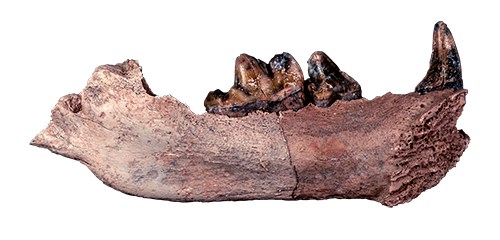Last updated: October 6, 2021
Article
The Bone-Crusher (Borophagus hilli)


Quick Facts!
- Common name: bone-crushing canid or hyena-like canid
- Scientific name: Borophagus hilli
- Meaning of scientific name: Borophagus means “voracious eater” (both boros and phag are Greek root words for “eating”) and hilli is for Dr. J. A. Hill, honoring his support of vertebrate paleontology
- Fossils found at Hagerman: left dentary (lower jaw) and distal phalanx (end of a digit)
- Present: Late Miocene to Pliocene
- Range: across North America
- Description: Approximately the size of a small wolf. Built like a hyena with a bulging forehead, powerful jaws, and sharp teeth.
Crushing it
The name Borophagus refers to an extinct genus of canids, dog-like carnivores who are members of the Canidae family. Though Borophagus has no living relatives, it was once a diverse and prominent group of bone-crushing carnivores in North America. Here at Hagerman Fossil Beds, the Borophagus genus is represented by fossils of the species Borophagus hilli.
Bone appetit
Borophagus hilli is thought to have filled a similar role in the North American food chain as hyenas do today in Africa, both scavenging for food and hunting in packs. Although it also devoured flesh, Borophagus hilli was well-adapted to crush and consume bone. Given the ample amount of carnivores present during the Pliocene in Hagerman, the capability to eat a carcass without wasting tough body parts like bones was beneficial for survival.
Doggone classification
As is frequently the case in the world of science, information is constantly being updated as new discoveries are made. For example, carnivores, including Borophagus hilli, are currently under taxonomic review. In other words, scientists are re-examining how carnivores are classified and their relationships to one another. What will the evidence suggest, and will it stand? Stay tuned for updates!
